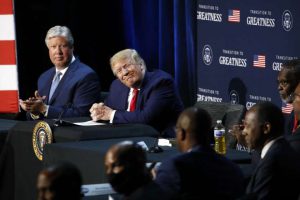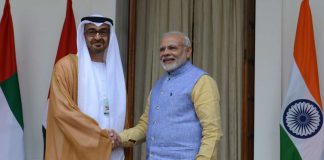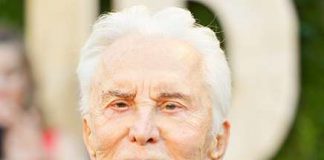JUNE 12, 2020

President Trump smiles during a roundtable discussion Thursday at Gateway Church in Dallas. (Alex Brandon / Associated Press)
President Trump drew a few laughs and hollers of approval Thursday when he railed against “the plague coming in from China” to supporters packed into a Dallas church.
But he didn’t dwell on public health concerns. The virus, “or whatever you want to call it,” as he told the crowd, is now just another throw-away line in Trump’s political patter, meant to jab a foreign adversary and energize his base.
Nearly six weeks after Trump stopped daily televised briefings at the White House that drew sharp criticism for his false claims and dangerous advice — such as injecting household disinfectant to kill the virus — he has a new tactic: ignoring the threat.
He rarely speaks of COVID-19, which has killed more than 114,000 people in the United States and more than 300,000 others elsewhere in the world. When he does mention it, he usually claims imminent victory — pledging on June 5, for example, to “stomp out” any “embers” of the disease.
Nor does he remind Americans to stay vigilant although confirmed cases increased in nearly two dozen states since they began reopening beaches, restaurants and other businesses and facilities. Oregon on Friday put a pause on its reopening to regain control as cases began to multiply.
Doctors have diagnosed more than 2 million U.S. infections so far, more than double the number of any other nation, even as public health experts warn that a second wave is likely in August or September, long before a potential vaccine appears possible.
The once-ubiquitous White House coronavirus task force, led by Vice President Mike Pence, now meets only once or twice a week behind closed doors and arranges one or two calls a week with state and local officials, according to a task force official. They hold no public briefings.
“Suddenly, the screen went blank,” said Dr. Jeffrey Koplan, a former director of the Centers for Disease Control and Prevention. If “they think that the risks are over, that’s dead wrong.”
The administration apparently has decided “politically it’s better for them not to engage in this pandemic,” he added.
“I’m concerned that we’re going to see some of the things that we’re already seeing,” said Dr. David Satcher, a former CDC director and U.S. surgeon general. “When people stop the social distancing and sheltering at home, we’re going to see a spike again in cases. There are already examples of it, and the fear is there are going to be more.”
That see-no-evil approach put the White House at odds with federal health officials Friday when the CDC urged organizers of large gatherings that involve shouting, chanting or singing to “strongly encourage” the use of cloth face coverings to lower the risk of spreading the coronavirus.
The CDC issued the guidelines two days after Trump said he would hold a reelection rally next Friday, his first since early March. He’ll address supporters in a 19,000-seat indoor arena in Tulsa, Okla., with other campaign rallies to follow in Florida, Arizona, and North Carolina — four states where cases have spiked.
Trump’s aides have not said what, if any, protections they will provide the crowd. But to get a ticket, attendees must sign a waiver pledging not to sue the Trump campaign if they catch the virus at the rally, suggesting their confidence has limits.
Trump, who has refused to wear a mask in public, has made clear he’s ready to move on. On Thursday, he flew to his golf club in Bedminster, N.J., for his first long weekend at one of his resorts since March.
While Trump has pressured states to reopen their economies, he has largely washed his hands of the details since early May. Without a coherent or detailed national plan, governors and local officials tried to fill the void as they juggled competing health and economic concerns.
“We cannot have COVID fatigue,” Kentucky Gov. Andy Beshear, a Democrat, warned Tuesday as he eased restaurant restrictions and announced a modified state fair. “We have to push on and do everything we can to defeat this virus.”
He pleaded for residents to stay vigilant as they reopen businesses, adding that “we continue to lose Kentuckians of all ages.”
Officials say states have been forced to come up with their own plans on how quickly to reopen, on hiring contact tracers and beefing up services to contain future outbreaks.
A task force official, who requested anonymity to defend its work, denied the administration is letting down its guard. But he acknowledged a shift toward pushing treatments, development of vaccines and lessons learned “to make sure people are confident in attempting to return to normalcy.”
That includes threatening to withhold federal money to compel states to test people in nursing homes and other elder care facilities, which have been especially hard hit by the coronavirus.
The official argued that state and local officials should be charged with managing response efforts, with federal backup. He asserted that White House Press Secretary Kayleigh McEnany, who briefs reporters several times a week, is delivering public health messages derived by the task force.
The White House approach has clear risks, especially with an election five months away. Many of the states that were quick to relax social distancing, including Florida and Georgia, are seeing increased infections.
A national wave of protests over racial injustice prompted Americans to congregate by the thousands over the last two weeks, though health experts say being outdoors could mitigate spread of the virus.
The Institute for Health Metrics and Evaluation at the University of Washington, one of the most prominent models, predicts a second wave of infections will begin in late August or early September.
Dr. Ali Mokdad, an epidemiologist at the institute, said infection rates and state responses have been uneven and that the next wave could see COVID-19 spikes in areas that largely escaped a heavy death toll so far.
Over the summer, he worried, many Americans will stop wearing masks and maintaining distance if their friends and family appear healthy, raising the risk of a new round of contagion.
Health experts say the administration should ensure an adequate supply of well-trained contact tracers to help find and isolate people who may have been exposed to the virus. The task force official could not say how many tracers have been trained nationally or how many would be needed.
Politics may also impact the size and power of the second wave. There is already a sharp division between Republicans and Democrats over whether to wear masks in public spaces.
Dr. Vivek Murthy, U.S. surgeon general under President Obama, notes that polls suggest many Americans won’t get a vaccine when one is available even though it’s the only to control the virus. He blames Trump’s politicization of the disease and his false claims on the science.
“In times of uncertainty, people need accurate information and they need to know what our plan is,” he said. “They’re not hearing much on either front.”
Courtesy/Source: LA Times











































































































